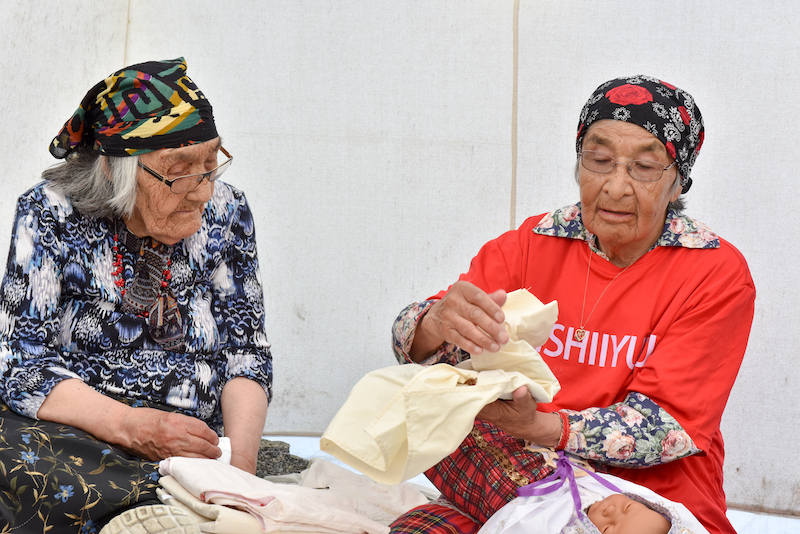The movement to return Cree births to the territory will take a step forward when a midwifery education program is launched by the Cree Board of Health and Social Services of James Bay (CBHSSJB) later this year.
The training initiative was approved in a CBHSSJB resolution last June. Although a university midwife degree is a four-to-six-year program combining science and social science courses with hands-on apprenticeships, Quebec’s Midwives Act enables Indigenous communities to provide training and provincial licences to their own midwives with equivalent competencies.
“The goal behind creating it differently is to build a program that is accessible, realistic and sustainable for Cree people and one that is more aligned with how Cree people learn and work,” said Jasmine Chatelain, a registered midwife and the program’s planning, programming and research officer.
The Cree program uses teaching materials from Nunavik’s Inuulitsiviup Nutarataatitsijingita Ilisarningata Aulagusinga (INIA), which started in 1986 as the first midwifery program of its kind. Chatelain and a small advisory group will travel to Nunavik in early April to learn from a program that enables nearly 95% of women to give birth in their communities.
“They have actually better outcomes than the south,” Chatelain told the Nation. “Lower pre-term labour, lower depression and addiction, better breastfeeding. The impact of a woman giving birth in the safety of her community is really big. I believe you’ll see in the next 20 or 30 years more Eeyouch women become low risk because we’re promoting this cycle.”
Cree midwives will learn traditional and modern techniques as they qualify to perform ultrasounds and other medical practices but also pass along cultural rites of passage. About 110 videos of Elder interviews are included in a training website, conveying rituals like the naming ceremony and kauutinaaushuut, which involves the person catches the newborn.
While there are currently no Cree midwives, natural midwives traditionally delivered babies on the land until the practice was outlawed in the 1970s. In 2016, a CBHSSJB midwifery demonstration in Chisasibi involving Chatelain and community Elders showed how the different practices could complement each other.
“Jane Matthew said why don’t we just pretend that we’re having a birth and see what it looks like,” recalled Chatelain. “It took us all day from beginning to end with a baby doll. I’m still emotional – people were sobbing even though it was a doll. Fast forward six years, we had that kind of birth for real at a lodge on the land. It was so healing for everyone.”
Since 2018, Quebec midwives have served about 250 clients in Chisasibi, resulting in an estimated 78 births in Eeyou Istchee. The midwives work with Cree birth assistants, who manage equipment, provide translation and integrate traditional practices.

A new interim birthing home featuring a bathtub, kitchen and other comforts of home, welcomed its first baby in November. A boarding home is also available for Cree mothers from other communities. Many midwife clients still don’t give birth on-territory because they may require hospitals for pre-natal or post-natal care.
“Midwives are experts in what you may call low-risk pregnancies,” explained Chatelain. “One of the reasons out-of-hospital birth is safe is because of screening – midwives are constantly looking for risk factors.”
Midwives are trained to manage complications and make appropriate referrals as trusted advisors for mothers before, during and after childbirth. They help mothers make informed choices and always support these decisions, even if that means going against medical recommendations to give birth down south.
While there is “overwhelming” interest in the program, only a limited number of applicants will be accepted at first. The advisory group hasn’t yet confirmed the application process, but the only education requirement will be to read and write in English, with qualities like patience and being able to act quickly emphasized.
“What’s important is a high level of commitment,” asserted Chatelain. “It’s very hard to be a midwife. It means that you live with disappointment, you miss family events, you can’t go away on Goose Break. You’re also responsible for two lives – you’ll miss happy days with your family in order to make a happy day for another family.”
The program is open to any Cree woman, but studying and working will be in Chisasibi, Waskaganish or Mistissini, where birthing homes are to begin construction in 2022. To be exposed to sufficient birth volume and medical procedures, students will initially be rotated more often to Chisasibi.
Along with tutorials and group discussion, students will primarily learn by doing – following experienced midwives as they assist births. Birth assistants interested in the five-year program may be credited for their accumulated experience.

“We’re talking about starting birth assistants at level two because that brings us to our goal faster and opens up space for other people,” Chatelain said. “We all need to do what we can to graduate as many midwives as quickly as we can.”
Birth assistant Shannon Chiskamish at Chisasibi’s Awash health clinic is so motivated to become a midwife that she applied to Ryerson University’s midwifery program before hearing about the Cree initiative. She first learned about midwifery while studying nursing down south, following a traumatic racist experience at a different nursing college.
“I love being here and coming to work,” Chiskamish told the Nation. “I’m so excited for the midwifery program to start. Seeing women here not being sent down south, they’re happier and they look forward to going home to their family usually three or four hours right after birth. That makes them happy.”
Chiskamish was present with her baby at that first meeting about bringing back midwifery in 2016. She understands how difficult it can be to both pursue studies and give birth far away from home.
“It’s a totally different feeling seeing these young mothers bringing life into this world at home, in the community,” shared Chiskamish. “It’s amazing. Seeing how proud of themselves they are afterwards with their babies in their arms, they’re always so thankful they decided to give birth here.”





